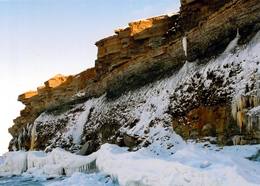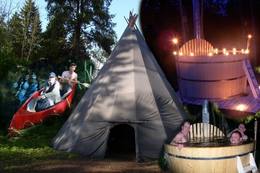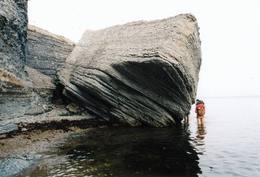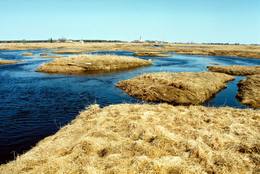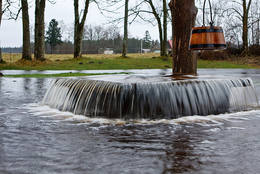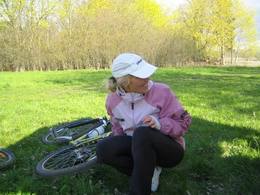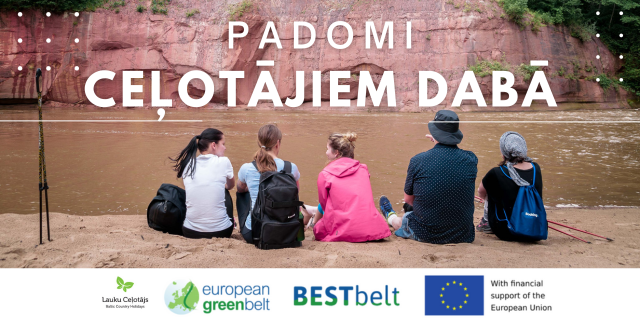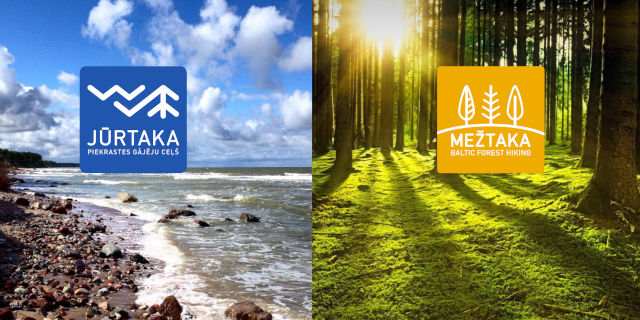Dabas objekti Igaunijā
Ar ko ievērojama daba Igaunijā?
Iespaidīgākā Baltijas klinšu siena – t.s. Ziemeļigaunijas glints, „Līču zeme” – Lahemā ar nacionālo parku, „Salu zeme” – Sāremā sala un Monzunda salu arhipelāgs, Matsalu līcis kā viena no nozīmīgākajām masveida putnu atpūtas vietām migrāciju laikā, viens no izcilākajiem Eiropas meteorīta krāteriem, izcilākie Baltijas dižakmeņi un ūdenskritumi, Munameģis – Baltijas augstākā virsotne, Peipuss – piektais lielākais Eiropas ezers – ar senām zivju ieguves tradīcijām un ārkārtīgi lielā dabas daudzveidība, kas ir acīmredzami mainīga gan austrumu – rietumu, gan ziemeļu – dienvidu virzienā, ir tikai dažas no Igaunijas valsts dabas pievilcībām.
Lai uzzinātu vairāk par apmeklējamām teritorijām aicinām izmantot vides vai vietējo gidu pakalpojumus. Esiet saudzīgi pret dabu ceļojuma laikā - ievērojiet Zaļos padomus!
| Pārskats | Detaļas |
|---|---|
|
Igaunija
Torņa kalns (Tornimägi)Karulas augstienes augstākais reljefa punkts (137 m.vjl.), kas virs tuvākās apkārtnes paceļas par ~ 60 m. Torņa kalnā ir uzbūvēts skatu tornis ar ļoti plašu apkārtskatu. Uz tā platformas ir novietoti panorāmas fotoattēli, kuros atzīmēti zīmīgākie plašākā apkaimē redzamie objekti – apdzīvotas vietas, pilskalni, baznīcu torņi u.c. Turpat izveidota atpūtas vieta un meklējams Rebases ainavu takas sākums. |
|
|
Igaunija
KasariPiektā lielākā Igaunijas sala. Dabas takas, putnu vērošanas tornis, Kassari kapela (18. gs.) un Sääre tirp oļu strēle, pa kuru var doties 3 km garā pārgājienā. Ar Hījumā to savieno divi dambji, pa kuriem uzbūvēts autoceļš. |
|
|
Igaunija
Pakri klintisVizuāli iespaidīgākā Baltijas valstu piekrastes klints siena (līdz 24 m augsta). Aukstās ziemās šeit veidojas fantastiski leduskritumi. Pakri bāka. |
|
|
Igaunija
NaissāreNaissāre ir viena no Igaunijas mazajām salām, kas periodā no II Pasaules kara beigām līdz 1993. gadam atradās Padomju armijas pārziņā. Savulaik - slepens padomju militārais objekts. Interešu objekti uz salas ir pastaigu takas, sugām bagātā daba, šaursliežu dzelzceļš, cara laika lielgabalu baterijas un jau minētās armijas jūras mīnu rūpnīca. No Tallinas uz Naissāri kursē kuģītis “Monica”. |
|
|
Igaunija
Letipeas Ehalkivi akmensLielākais Baltijas (pēc dažiem avotiem – arī Ziemeļeiropas daļas, ko skāris pēdējais apledojums) dižakmens. Tā tilpums ir 930 m3! Akmens augstums ir 7,5 m, garums – 16,5 m, platums – 14 m, bet apkārtmērs – 48,5 m. Ehalkivi, kas iztālēm atgādina milzu oli, „stāv” uz smilšaini - akmeņaina sēkļa, kas atkarībā no laika apstākļiem vai gadalaika var atrasties ūdenī. Ledājs to „atnesis” no Somijas D piekrastes. Pēc sastāva - pegmatīts.
|
|
|
Igaunija
Lahemā tūrisma centrsLahemā tūrisma centrs ir izveidots ar nolūku mudināt piekopt dabai draudzīgu dzīves stilu un uzturēšanos dabā – te tiek stādīti koki, būvēti un uzstādīti putnu būri. Interesentiem piedāvājam laivošanu ar kanoe laivām Lahemā nacionālajā parkā, pārgājienus pa purvu, piedzīvojumus loka un arbaleta šaušanas trasē. Kamīna zālē un pirtī ar kublu var mājīgi pavadīt brīvo laiku. |
|
|
Igaunija
Otepää augstieneViena no trijām Dienvidigaunijas augstienēm ar ainaviskiem pauguriem un skaistām skatu vietām. Tās „centrā” iegūlis līčiem bagātais Pühajärv ezers (tulkojumā – Svētezers). |
|
|
Igaunija
Sõrve säärGalējais Saaremaa salas dienvidu punkts – oļaina strēle, kas iestiepjas Irbes šaurumā. Militārie nocietinājumi, bāka (1960. g.), putnu vērošanas vieta. |
|
|
Igaunija
Tahkuna ragsTālākais Hiiumaa salas ziemeļu punkts. Igaunijas augstākā čuguna bāka (1873. – 1875. g.) un piemineklis kuģa „Estonia” bojā gājušo piemiņai. |
|
|
Igaunija
Kaali meteorīta krāterisViens no Eiropas iespaidīgākajiem krāteru laukiem. Galvenā krātera dziļums ir 22 m, diametrs – 110 m. Meteorīts nokritis pirms ~ 7,5 tūkstošiem gadu. |
|
|
Igaunija
Pakri salasDivas salas – Lielā Pakri (Suur Pakri) un Mazā Pakri (Väike Pakri) - 3 km R no Paldiskiem (Paldiski). Padomju laikā tās izmantoja kā armijas aviācijas poligonu, par ko liecina daudzās bumbu bedres un munīcijas paliekas. Salas klāj g.k. retas kadiķu audzes, bet to Z, ZA galos paceļas iespaidīgas līdz 6 m augstas kaļķakmens klintis.
|
|
|
Igaunija
Jumindas rags (Juminda neem, Juminda nina)Jumindas pussala beidzas ar Jumindas ragu (tā galā ir autostāvlaukums un telšu vieta), kura tuvākajā apkārtnē ir apskatāmi vairāki interesanti objekti: meža malā guļošs Padomju armijas raķetes makets („Aukstā kara” sākumā - pretinieka maldināšanai), senkapi, kas dabā izpaužas kā iespaidīga akmeņu kaudze, 32 m augstā Jumindas bāka (Juminda tuletorn), ko var apskatīt tikai no ārpuses un piemineklis 2. pasaules kara laika upuriem, kas gāja bojā Somu līča izvietotajos mīnu laukos. Neitralizēto jūras mīnu apvalki ir neparastā pieminekļa sastāvdaļa. Somu līča kuģu kapsētās guļ arī daudzi kādreiz Latvijai piederošie kuģi. Apmeklējams ir arī dienvidos esošais Jumindas ciems. |
|
|
Igaunija
Suitsu tornis (Suitsu torn)Suitsu tornis celts 1979. g. kā pirmais Matsalu rezervāta metāla tornis. To atjaunoja 1998. g. Torņa augstums ir 21 m, tādēļ no tā paveras izcila dabas un kultūrainava uz Kazari deltas niedrājiem un blakus esošo Suitsu upi (Suitsu jõgi), kuras krastā ir uzceltas vairākas zvejnieku laivu būdas. |
|
|
Igaunija
Skats uz Vaikas salām (Vaika saared)No Vilsandi bākas un tai tuvākās apkaimes ir labi saskatāmas leģendārās Vaikas salas. Tām ir piešķirts rezervāta statuss, tādēļ salas var apskatīt tikai no attāluma. Mazākā no saliņām - Kullipank ir tikai pārdesmit metrus diametrā. Tā ir jūras ūdeņu izrobots zemas un asas dolomīta klints fragments, kas klāts ar oļiem, nelieliem laukakmeņiem un kādu atsevišķi stāvošu lakstaugu. Domājams, ka vētru laikā tā pazūd zem jūras ūdens. Savukārt, Alumine Vaigas – Apakšējā Vaikas sala ir lielākā no sešām salām. Šīs salas diametrs ir ~ 150 m un tā paceļas vismaz kādus divus metrus virs jūras līmeņa. Uz salas ir bagātīga veģetācija un pat kāds zems krūms salas centrā. Redzami arī metru augsti atsegumi. Uz salas vēl joprojām atrodas 20. gs. sākumā celto „putnu māju” paliekas, kas bija domātas ligzdojošo putnu piesaistīšanai. |
|
|
Igaunija
Saulas Zilie avotiPiritas upes kreisajā krastā izveidojušies trīs avotu ezeriņi ar daudzām izverdošām avotu „acīm” – katrs savā krāsā (zilganzaļā, baltā un tumšā), veidojot dažādas krāsu kombinācijas. Nereti saukti par Igaunijas skaistākajiem avotiem. Kopējais no tiem izplūstošā ūdens daudzums ir 20 – 30 l/s. Saglabājušies nostāsti par avotu dziednieciskajām (īpaši – acīm) īpašībām. Apkārtne labiekārtota.
|
|
|
Igaunija
Leti tornis (Läti torn)Jēsū – Kepu ceļa malā pie Leti (Läti) ciema ir izveidots autostāvlaukums ar putnu vērošanas torni, no kura paveras skats uz Hallistes upes palieņu pļavām un tuvējā ciema apkārtni. Stipru palu laikā arī no šī torņa redzamā apkārtne (izņemot ceļus) var atrasties zem ūdens. Laba putnu vērošanas vieta. Läti tulkojumā no igauņu valodas nozīmē Latvija. |
|
|
Igaunija
Kostiveres karsta lauksIgaunijas vizuāli izteiksmīgākais karsta lauks 125 ha platībā ar dažādām karsta procesu izpausmēm – pazemes strautiem, Jēlehtmes (Jõelähtme) upes sausgultni, karsta avotiem, piltuvēm, gravām, alām, pamatiežu atsegumiem, savdabīgu akmens „sēni” u.c. Pavasaros tas applūst, bet mazūdens periodā labi apskatāmas minētās karsta formas.
|
|
|
Igaunija
Karulas nacionālais parksParks atrodas Karulas augstienes paugurainajā apvidū, kura vidusdaļā iegūlis Ähijärve ezers. Parks veidots kultūrvides, ainavas ar nelielām lauku sētām un savdabīgo kupolveidīgo pauguru aizsardzībai.
|
|
|
Igaunija
Vikingu ciematsUnikālais tematiskais parks pirmatnējās Piritas upes krastā ir izveidots ar mērķi apmeklētājiem raisīt interesi par seno vikingu diženumu. Iespējas: vikingu pils, buršanās slietenis, smēde, senlaiku spēles, teatralizēti uzvedumi, izbrauciens vikingu kuģi pa Piritas upi bagātību meklējumos, vizināšanās vienkoču laivās, kaujas ar akmeņu metamām ierīcēm, loka šaušana, cirvja mešana, alas un melnā pirts, foreļu makšķerēšana, ekstrēma nakšņošana, ēdināšana u.tml. |
|
|
Igaunija
Gaujas kultūras mantojuma taka (Koiva pärandkultuuri rada)2010. gada rudenī tapa 60 km garā velotaka, kas iepazīstina ar Igaunijas un Latvijas kultūras mantojuma objektiem, kas sastopami Gaujas kā valstu robežupes krastos. Taka sākas no Tellingumē stāvvietas. Tās abos galos un robežas šķērsošanas vietā ir iekārtotas atpūtas vietas un izlikti informācijas stendi ar trases shēmu. Nenomaldīties palīdz norādes. |
|
|
Igaunija
Klostri (Kloostri) skatu tornisMetāla tornis Kazari upes kreisajā krastā, ~ 5 km attālumā no Matsalu līča. No torņa redzamās Kazari deltas palieņu pļavas atrodas tikai 0,3 – 1 m augstumā virs jūras līmeņa, tādēļ pavasara palos un stipru vētru (īpaši rietumvēju) laikā ūdens appludina milzīgu teritoriju. Uzskata, ka platības ziņā šīs ir vienas no lielākajām Eiropas palieņu pļavām, kas ir nozīmīga dažādu tārtiņveidīgo putnu sugu ligzdošanas, dzērvju un zosveidīgo putnu atpūtas un barošanās vieta. Ir pagājis laiks, kad zemnieki Matsalu pļavās ganīja govis un pļāva sienu, tādēļ šobrīd pļavu apsaimniekošanu veic nacionālā parka administrācija. |
|
|
Igaunija
Piusas upes senleja un Piusas alas~ 15 km garš Piusas senlejas posms starp Vana - Vastseliina un Ignasõ ciemiem, kur upei novērojams liels kritums, ātras straujteces un skaisti Devona perioda smilšakmens atsegumi, no kuriem Hermas siena (Härma müür) ir augstākais (ar senlejas nogāzi – 43 m) smilšakmens atsegums Igaunijā. Piusas ciemā atrodas Piusas raktuvju alas. Tikai pavisam neliela daļa no > 10 km garās Piusas raktuvju sistēmas ir eksponētas un labiekārtotas kā apskates objekts.
|
|
|
Igaunija
Nemmeveski ūdenskritums (Nõmmeveski juga)No vairākiem parka ūdenskritumiem noteikti ir jāapmeklē divi. 1,2 m augstais vienpakāpes Nemmeveski ir izveidojies uz Valgejegi upes (Valgejõgi), vietā kur tā šķērso Ziemeļigaunijas glintu. Šeit Valgejegi atgādina krāčainu (īpaši – pavasaros) kalnu upi, kas plūst pa vairākus metrus augstu klinšu ieskautu kanjonu. Palu laikā šo upes posmu ir iecienījuši ekstrēmie ūdenssporta veidu cienītāji. Pie ūdenskrituma un tālāk pa upi lejup redzamas ap 1920. g. celtās hidroelektrostacijas konstrukciju paliekas. |
|
|
Igaunija
Eldas klints (Elda pank) un pussalaNacionālā parka dienvidrietumdaļā jūrā iestiepjas Eldas pussala – skaists un ļoti omaļš ar kadiķu mežu (alvāriem) noaudzis zemes pleķītis ar interesantu jūras krastu, kur atsedzas silūra perioda nogulumieži. No pussalas gala, kurā slejas vecs Padomju armijas robežsargu tornis (apmeklējumam bīstams!), paveras visaptverošs skats uz Vilsandi salu (atpazīstama pēc bākas), Lonalaidas salu (Loonalaid) – otru lielāko Vilsandi arhipelāgā, Salavu (Salava) un citām mazākām saliņām. Dabas mīļotāji var uzmeklēt Eldas klinti (Elda pank) – ~ 2 m augstu un 0,4 km garu atsegumu, kura piekājē var atrast interesantas ūdens izskalotas fosilijas. |
|
|
Igaunija
Viru purva taka (Viru raba matkarada)3,5 kilometrus gara taka, kas Viru purvu šķērso dienvidu – ziemeļu virzienā. Takas sākums ir jāmeklē pie Vahastu – Loksas (Loksa) ceļa. Viru purvā ir uzcelts koka skatu tornis, no kura atklājas tipiska sūnu (augstā) purva ainava ar nelielu ezeriņu, lāmu un akaču kopu. Taka nav lokveida, tādēļ ir jāpadomā par šī maršruta veikšanas loģistiku! Tās apskatei būs nepieciešama ~ 1h. Jāpiebilst, ka šī ir viena no interesantākajām nacionālā parka takām! |
|
|
Igaunija
Mejekoses pārgājienu taka (Meiekose matkarada)~ 3 – 5 km gara taka, kas ved pa veco ceļu gar Tēramā upes (Tõramaa jõgi) kreiso krastu. Takas malās izvietoti interaktīvi elementi bērniem, kas palīdz labāk uztvert dabā notiekošo. Taku ieskauj mitrie meži un palieņu pļavas, kas palu laikā atrodas zem ūdens. Tēramā (Tõramaa) ciemā apkārtnē atrastas cilvēka darbības pēdas jau no akmens laikmeta. |
|
|
Igaunija
Otepää slēpošanas centrsLielākais Baltijas valstīs. Tartu maratona trase, mākslīgo klinšu siena un velomaratorna trase. Slēpju muzejs. Tehvandi tramplīnā – skatu platforma. |
|
|
Igaunija
Hjupasāres pārgājienu taka (Hüpassaare matkarada)Iepazīstina ar Somā nacionālā parka lielākā purva – Kureso (Kuresoo) ziemeļaustrumu daļu, kur redzamas purva ezeriņu un lāmu ainavas. Takas sākumā atrodas igauņu komponista, ērģelnieka un folkloras vācēja Marta Sāra (Mart Saar) (1882. – 1963.) dzimtās mājas. To apkaimē pļavas apsaimnieko aitas. Lokveida takas garums ir 4,2 km. |
|
|
Igaunija
Ilumetsas meteorīta krāteriTrīs krāteri, no kuriem lielākā – Elles kapa (Põrguhaud) diametrs ir ~ 80 m, dziļums līdz 12 m. To ietver vairākus metrus augsti vaļņi. Pārējie krāteri ir dabā grūti atrodami un atpazīstami. Krāteru vecums ir ~ 6000 gadi. Līdz šim gan nav atrastas meteorīta atliekas, kas apstiprinātu to izcelsmi.
|
|
|
Igaunija
Kēmu skatu tornis (Keemu vaatetorn)Meklējams Matsalu līča dienvidu krastā pie Kēmu ostas (Keemu sadam). Blakus sešus metrus augstajam metāla – koka tornim uzcelts neliels apmeklētāju centrs. Tāpat kā no Haeskas torņa, arī no šī paveras viena no izcilākajām Matsalu līča un tā piekrastes ainavām. Laba putnu vērošanas vieta migrāciju laikā. |
|





